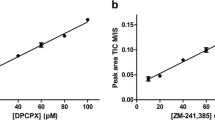Abstract
Upon the study of small-molecules binding to proteins, the traditional methods for calculating dissociation constants (K d and K i ) have shortcomings in dealing with the single binding site models. In this paper, two equations have been derived to solve this problem. These two equations are independent of the total concentration or initial degree of saturation of receptor and the activity of the competitive molecule. Through nonlinear fitting against these two equations, K d value of a probe can be obtained by binding assay, and K i value of a ligand can be obtained by competitive assay. Moreover, only the total concentrations of receptor([R]t), ligand([L]t) and probe([P]t) are required for the data fitting. In this work, K i values of some typical ligands of PPARγ were successfully determined by use of our equations, among which the K i value of PPARγ-LY171883 was reported for the first time.
Similar content being viewed by others
References
Harvey, M., The GraphPad Guide to Analyzing Radioligand Binding Data, http://www.graphpad.com/www/radiolig/radiolig. htm, 2003.
Cheng, Y., Prusoff, W. H., Relationship between the inhibition constant(Ki) and the concentration of an inhibitor that causes a 50% inhibition (I50) of an enzymatic reaction, Biochemical Pharmacology, 1973,22: 3099–3108.
Henke, B. R., Blanchard, S. G., Brackeen, M. F. et al., N-(2-Benzoylphenyl)-L-tyrosine PPARg Agonists. 1. Discovery of a novel series of potent antihyperglycemic and antihyperlipidemic agents, Journal of Medicinal Chemistry, 1998, 41(25): 5020–5036.
Qiong, L., Sarah, E. R., Natacha, S. S. et al., Ligand selectivity of the peroxisome proliferator—activated receptor a, Biochemistry, 1999, 38(1):185–190.
Robert, L. M., Franco, R., Irwen, H. S., A simple method for calculating the dissociation constant of a receptor, Archieves of Biochemistry and Biophysics, 1991, 284(1): 26–29.
Mangelsdorf, D. J., Thummel, C., Beato, M. et al., The nuclear receptor superfamily: the second decade, Cell, 1995, 83(6): 835–839.
Timothy, M. W., Peter, J. B., Daniel, D. S. et al., The PPARs: From orphan receptors to drug discovery, Journal of Medicinal Chemistry, 2000,43(4): 527–550.
Causevic, M., Wolf, C. R., Palmer, C. N. A., Substitution of a conserved amino acid residue alters the ligand binding properties of peroxisome proliferator activated receptors, Federation of European Biochemiacal Societes Letters, 1999, 463(3): 205–210.
Tontonoz, P., Graves, R. A., Budavari, A. I. et al., Adipocyte-specific transcription factor ARF6 is a heterodimeric complex of two nuclear hormone receptors, PPAR gamma and RXR alpha, Nucleic Acids Research, 1994, 22(25): 5628–5634.
Tontonoz, P., Hu, E., Spiegelman, B. M., Stimulation of adipogenesis in fibroblasts by PPAR 2, a lipid-activated transcription factor, Cell, 1994, 79(7): 1147–1156.
Ferry, G., Bruneau, V., Beauverge,r P. et al., Binding of prostaglandins to human PPARg: tool assessment and new natural ligands, European Journal of Pharmacology, 2001, 417(3): 77–89.
Brown, P. J., Smith-Oliver, T. A., Charifson, P. S. et al., Identification of peroxisome proliferator-activated receptor ligands from a biased chemical library, Chem. Biol., 1997, 4(12): 909–918.
Jeff, E. C., Steven, G. B., Evan, G. B. et al., N-(2-benzoylphenyl)-L-tyrosine PPARg agonists. 3. Structure-activity relationship and optimization of the N-aryl substituent, Journal of Medicinal Chemistry, 1998, 41(25): 5055–5069.
Dowell, P., Peterson, V. J., Zabriskie, T. M. et al., Ligand-induced peroxisome proliferator-activated receptor a conformational change, The Journal of Biological Chemistry, 1997, 272(3): 2013–2020.
Grigorios, K., Olivier, B., Fabienne, L. H. et al., Fatty acids, eicosanoids, and hypolipidemic agents identified as ligands of peroxisome proliferator-activated receptors by coactivator-dependent receptor ligand assay, Molecular Endocrinology, 1997, 11(6):779–791
Nichols, J. S., Parks, D. J., Consler, T. G. et al., Development of a scintillation proximity assay for peroxisome proliferator-activated receptor ligand binding domain, Analytical Biochemistry, 1998, 257(2): 112–119.
Palmer, C. N. A., Wolf, C. R., cis-Parinaric acid is a ligand for the human peroxisome proliferator activated receptor g: development of a novel spectrophotometric assay for the discovery of PPARg ligands, Federation of European Biochemiacal Societes Letters, 1998, 431(3): 476–480.
Berde, C. B., Kerner, J. A., Johnson, J. D., Use of the conjugated polyene fatty acid, parinaric acid, in assaying fatty acids in serum orplasma, Clinical Chemistry, 1980, 26(8): 1173–1177.
Palmer, C. N. A., Hsu, M.-H., Muerhoff, A. S. et al., Interaction of the peroxisome proliferator-activated receptor alpha with the retinoid X receptor alpha unmasks a cryptic peroxisome proliferator response element that overlaps an ARP-1-binding site in the CYP4A6 promoter, The Journal of Biological Chemistry, 1994, 269(27): 18083–18069.
Sklar, L. A., Hudson, B. S., Petersen, M. et al., Conjugated polyene fatty acids on fluorescent probes: spectroscopic characterization, Biochemistry, 1977, 16(5): 813–818.
Christopher, G. M., Hudson, B., Wolber, P. K., Photochemical dimerization of parinaric acid in lipid bilayers, Proc. Natl. Acad. Sci. USA, 1980, 77(1): 26–30.
Collins, J. L., Blanchard, S. G.., Boswell, G. E. et al., N-(2-Ben-zoylphenyl)-L-tyrosine PPARg agonists. 2. Structure-activity relationship and optimization of the phenyl alkyl ether moiety, Journal of Medicinal Chemistry, 1998, 41(25): 5037–5054.
Kliewer, S. A., Lenhard, J. M., Willson, T. M. et al., A prostaglandin J2 metabolite binds peroxisome proliferator-activated receptor and promotes adipocyte differentiation, Cell, 1995, 83(5): 813–819.
Leesnitzer, L. M., Parks, D. J., Bledsoe, R. K. et al., Functional consequences of cysteine modification in the ligand binding sites of peroxisome proliferator activated receptors by GW 9662, Biochemistry, 2002, 41(21): 6640–6650.
Author information
Authors and Affiliations
Corresponding authors
Rights and permissions
About this article
Cite this article
Gao, Z., Luo, H., Chen, L. et al. Determining PPARγ-ligand binding affinity using fluorescent assay with cis-parinaric acid as a probe. Sc. China Ser. B-Chem. 48, 122–131 (2005). https://doi.org/10.1360/03yb0217
Received:
Issue Date:
DOI: https://doi.org/10.1360/03yb0217




